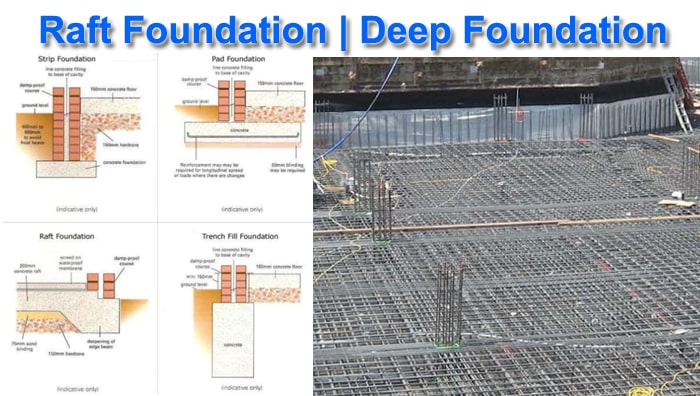Raft Foundation Types | Raft Footings Detail | Working with Raft Foundation
Basics of Raft Foundation:
A raft foundation is a reinforced concrete slab that spans the whole footprint of a structure or addition and floats on the ground as a raft does on water. This foundation distributes the building’s load across a broader area than other foundations, reducing ground pressure.
If you can’t use typical strip or trench fill foundations, this is an option.
It’s crucial to note, however, that raft foundations aren’t always appropriate and must be developed by a structural engineer.
The foundations of bridges and buildings, in general, can be classified into two major groups, as shown below.
- Shallow foundations
- Deep foundations
If you’re considering employing a raft foundation, keep the following points in mind:
A cage of steel reinforcement forms an ‘edge beam’ in most raft designs, which must be carefully built on site. Internal stiffening beams are occasionally required as well. The building loads are transferred through the rest of the slab and then equally distributed across the ground by these beams.
In order for the engineer to grasp what the ground is like, he or she will need to do a site investigation. If the ground is very bad, you may need to use an alternative option, such as piles.
To level the ground, most raft designs will require a hardcore sub-base. This stone should be compressed mechanically.
Steel reinforcement must be lapped at least 450mm (for both mesh and mild steel bars) and a 40 mm concrete cover must be provided. ‘ ‘Treading in’ the reinforcement during the concrete pour isn’t a good idea; instead, use the special ‘chairs’ or soldiers to hold the mesh in place.
The damp course and membrane position at the raft edge must be meticulously described, which may necessitate building a step in the concrete at the raft edge.
Insulation is typically applied to the top of the raft; however, cold bridging at the joints with external walls should be avoided.

What is Shallow Foundation?
A stepped foundation is another name for a shallow foundation. Shallow or stepped foundations are those in which the depth of the foundation is smaller than the breadth of the foundation.
Shallow foundations can be employed where the carrying capacity of the soil on which the structure is to be built in the highest. This foundation’s minimum depth is 800mm, with a maximum depth of no more than 4 meters.
Types of Shallow foundations:
- Isolated Footing or Column Footing
- Wall Footing
- Continuous Footing
- Inverted arch Footing
- Spread Footing
- Raft or mat Footing
- Combined Footing
- Strap or cantilever Footing
What is deep foundation?
Deep foundations are needed to transport loads from a structure through weak compressible soils or fill into deeper, stronger, and less compressible soils or rocks, or for other functional reasons.
Deep foundations are built too far below the finished ground surface for their base carrying capacity to be impacted by surface circumstances; depths of >3 m below finished ground level are common. If inappropriate soils are available near the surface, a deep foundation can be employed to shift the load to a deeper, more capable strata at depth.
Types of Deep foundation:
- Basements
- Buoyancy Rafts (hollow box foundations)
- Caissons
- Cylinders
- Shaft foundations
- Pile foundations





